Who Comes in First at a Wedding? Understanding the Processional Order
Planning your wedding ceremony can be full of intricate details, but one of the first questions to address is the order in which the participants enter. Traditional wedding processionals are carefully choreographed, with each person’s entrance timed to perfection, setting the stage for a memorable ceremony. If you’re curious about who traditionally comes in first at a wedding, it depends largely on cultural and personal preferences.
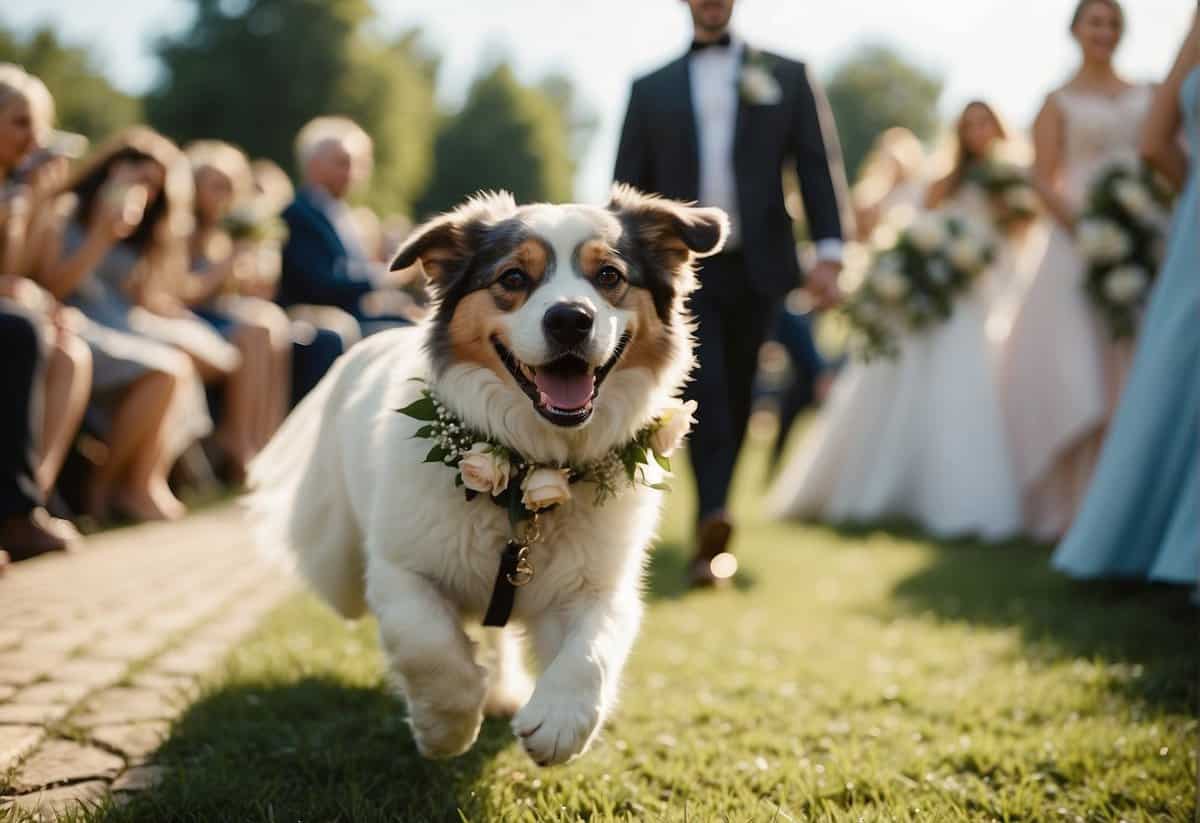
In a standard Christian procession, the officiant often makes their way to the altar first, signaling the commencement of the affair. Following the officiant, the groom, best man, and the rest of the wedding party make their entrances. The climax of the processional is marked by the arrival of the bride, who is customarily escorted down the aisle. Other cultures and religious ceremonies might differ in their processional order, reflecting their unique customs and traditions.
Key Takeaways
- The processional order is steeped in tradition, varying by culture and religion.
- Details of the procession are usually outlined in the wedding invitations.
- Understanding procession etiquette ensures a smoothly run ceremony and reception.
Wedding Ceremony Procession

The wedding ceremony procession marks the official start of your special day. It’s the moment when the bridal party and close family members make their grand entrance before your vows are exchanged.
Order of Entrance
The processional begins traditionally with the officiant taking their position, often at the front of the ceremony space, symbolizing the commencement of events. Here’s the typical order:
- Grandparents of the bride and groom
- Parents of the groom
- Mother of the bride, who may be escorted by an usher or a family member
- Groom, who may also be escorted, often walks in from the side
- Best man, either accompanying the groom or entering separately
- Groomsmen, who may enter as a group, individually, or escorting the bridesmaids
- Bridesmaids, typically walking down the aisle one by one, or paired with groomsmen
- Maid of Honor, walking alone right before the flower girl and ring bearer
- Ring Bearer and Flower Girl, often the final members of the party before the bride
- Bride, traditionally escorted by her father or a significant family member
Roles of the Wedding Party
The wedding party has specific roles during the procession.
- Bridesmaids and groomsmen set the stage for the bride’s entrance.
- Maid of Honor carries the bride’s train or bouquet and stands by her side.
- Best Man holds the wedding rings and supports the groom.
- The flower girl scatters petals to prepare the aisle for the bride.
- The ring bearer carries a symbolic pillow with the rings.
Remember, each role is significant as they contribute to the flow and feel of your ceremony, and every entrance is a moment that will be remembered.
Wedding Invitations Detailing
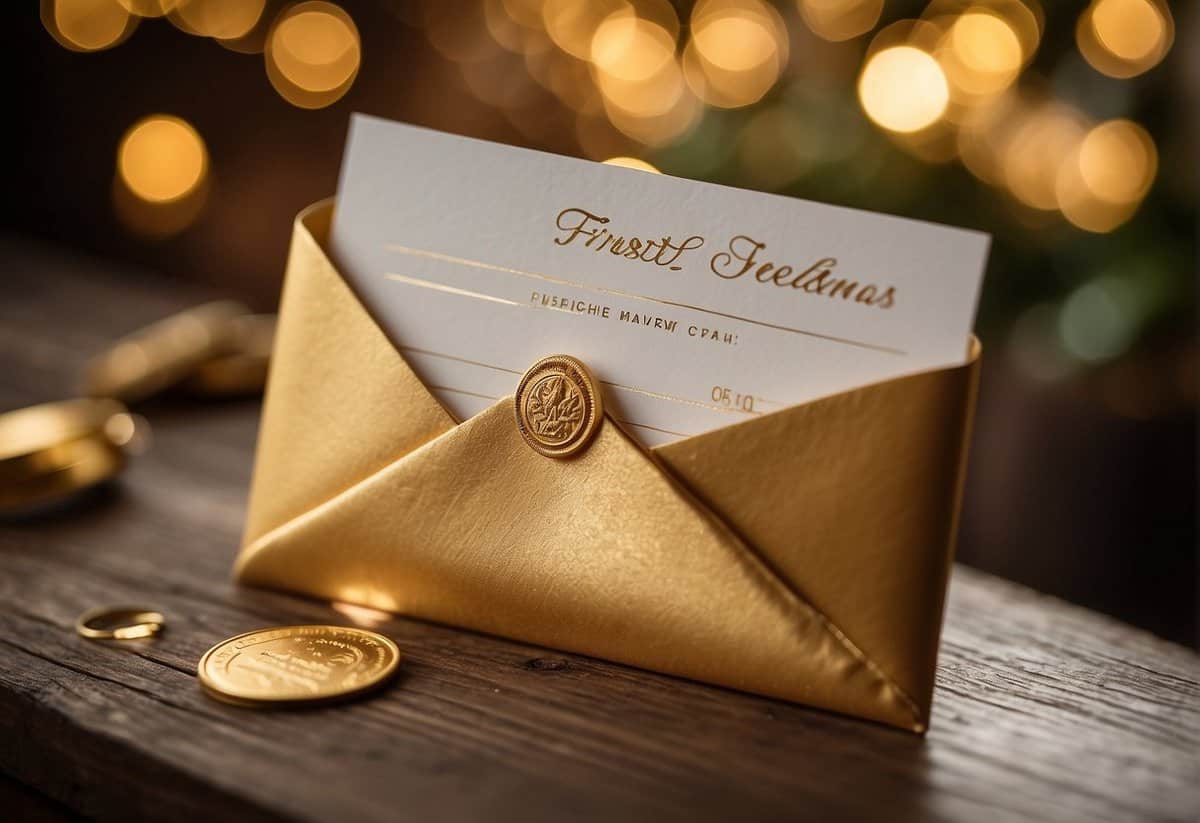
Creating the perfect wedding invitation involves more than just selecting beautiful stationery—it’s about crafting a personalized announcement that sets the tone for your special day and provides essential information to your guests.
Composition and Wording
When you’re deciding on the composition of your wedding invitations, it’s important to include several key elements to ensure your guests have all the details they need. Traditionally, the invitation should start with the names of the hosts (typically the parents) issuing the request for guests’ presence. An example of classic wedding invitation wording could be:
- Host Line: “Mr. and Mrs. John Smith request the honor of your presence…”
- Names: The bride’s name often precedes the groom’s name using her first and middle name, while the groom’s full name follows. For example, “Emma Louise to Jacob Andrew Wilson.”
- Date and Time: Be explicit and include the day of the week, such as, “Saturday, the twenty-fourth of June…”
- Location: Provide the full address for the convenience of your guests.
Remember that for save the date cards, you can be less formal and more creative, but still include both your initials or names and the wedding date.
You’ll also want to consider RSVP details and registry information if you’re including that directly on the invitation or on separate wedding stationery inserts.
Sending Invitations
Your wedding invitations play a critical role in managing your special event, so timing is crucial. Here’s a quick guide:
- Save the Dates: It’s customary to send these out six to eight months before the wedding.
- Invitations: Aim to mail these no later than eight weeks before your wedding date.
This timeline ensures your guests have ample time to RSVP and make necessary travel arrangements.
Hosts and Etiquette
When planning your wedding, understanding the roles of the hosts and adhering to traditional etiquette can give your invitations a touch of grace. Yet, modern twists allow personalization that can reflect your unique situation.
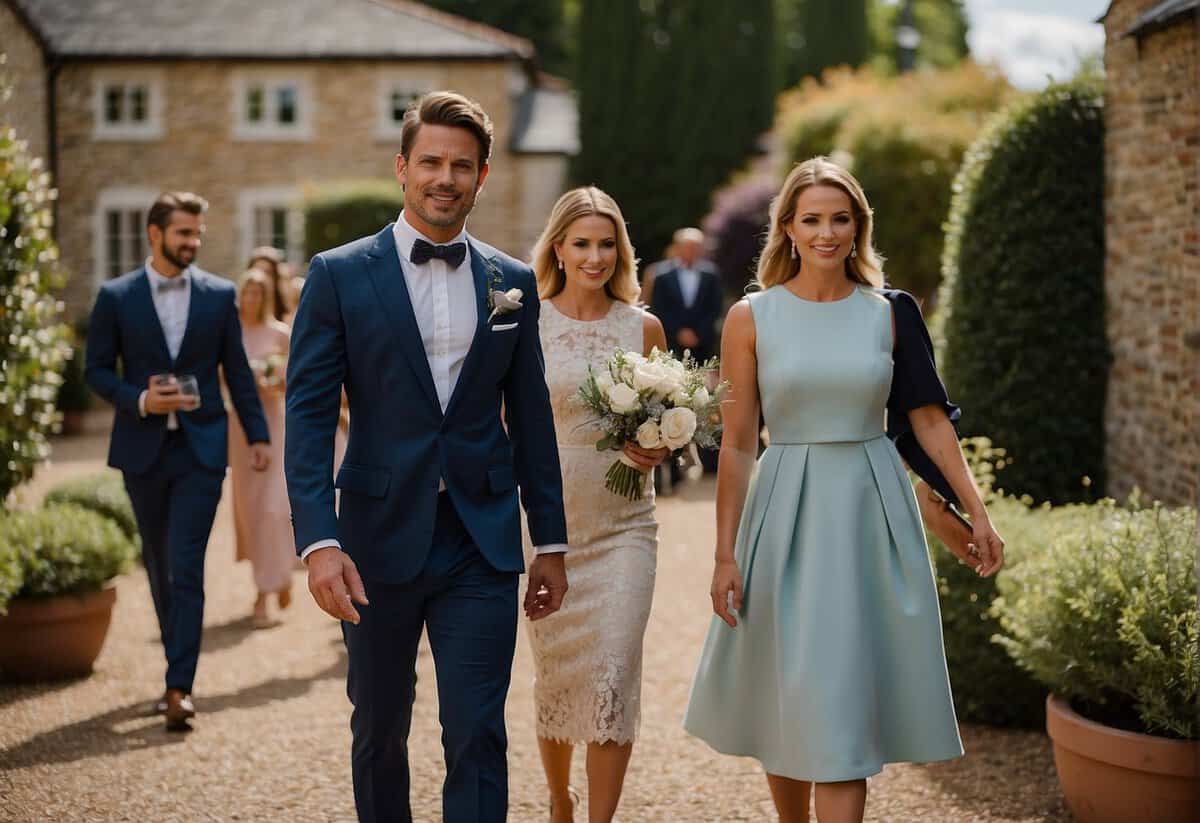
Identifying the Hosts
Who’s hosting? Traditionally, the host is the person or persons footing the bill, often the bride’s parents. The naming order on the invitation starts with their names as a token of acknowledgement for hosting the wedding and the associated events, such as the rehearsal dinner. Cultural tradition may dictate variations, but generally, it’s about honoring the contributors to your big day.
Modern Etiquette Considerations
In modern wedding planning, etiquette has evolved to accommodate diverse family structures and cultural traditions. For same-sex couples, alphabetical order or a preference for the symmetrical appearance of first names may guide the decision. Remember, it’s your day! Whether you’re sticking with traditional etiquette or crafting a unique approach, ensure that the spirit of gratitude towards your hosts shines through.
Reception and Celebration
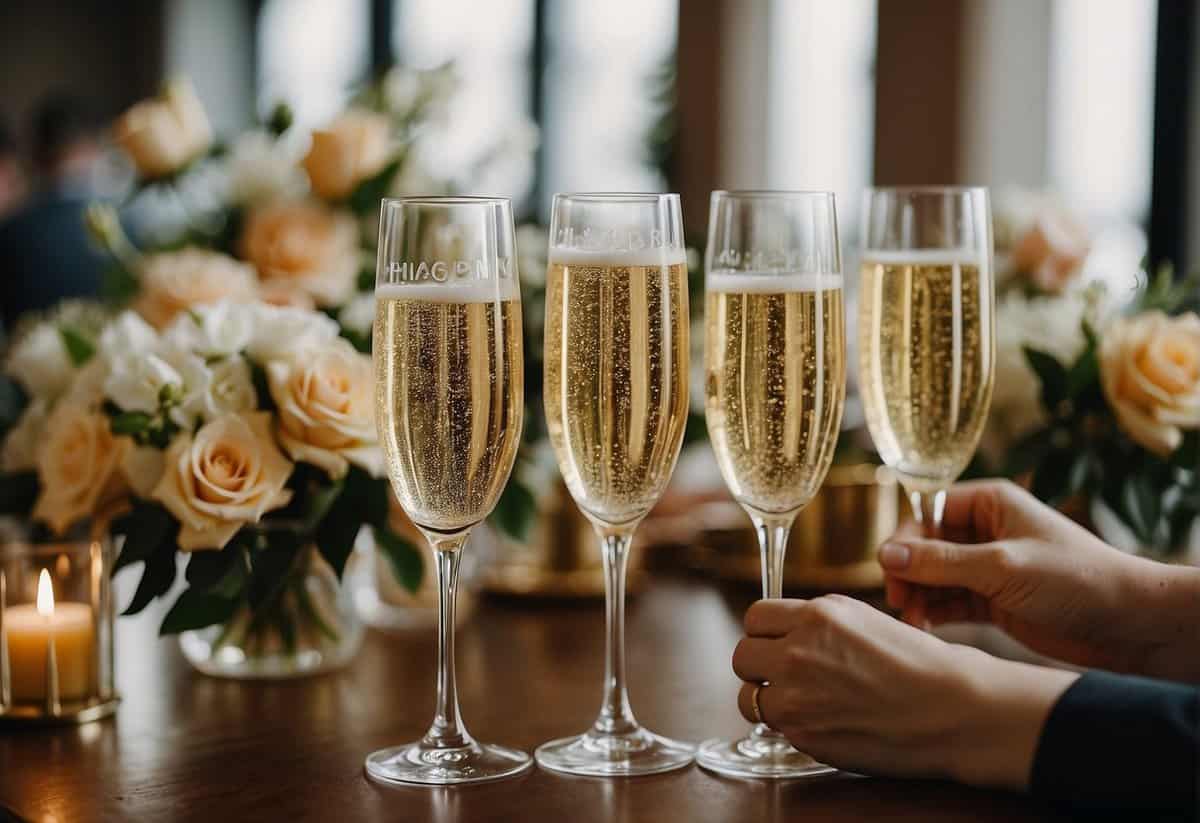
Your special day continues into the evening with the reception—a festive time where the newlyweds, wedding party, and guests come together to celebrate. Every detail, from the dress code to the wedding cake, contributes to the joyous atmosphere.
Reception Arrangements
When you make your way to the reception venue, expect to be greeted by the beautifully arranged tables with carefully selected napkins and decor. As a part of the wedding party, it’s essential you’re aware of the seating arrangements: the bride and groom typically enjoy the prominence of a head table, while parents, bridesmaids, and groomsmen are thoughtfully placed. Professional wedding planners will have orchestrated these arrangements down to the finest detail to ensure a seamless flow of the evening’s events.
Ceremonial Elements
Among the cherished rituals, the best man and maid of honor might offer heartfelt toasts to commemorate the union, followed by a blessing if the couple chooses. You’ll then witness the cutting of the wedding cake—a moment that symbolizes the first activity done together as a married couple. Keep your camera ready; this is one of those picture-perfect moments you’ll want to cherish.
Frequently Asked Questions
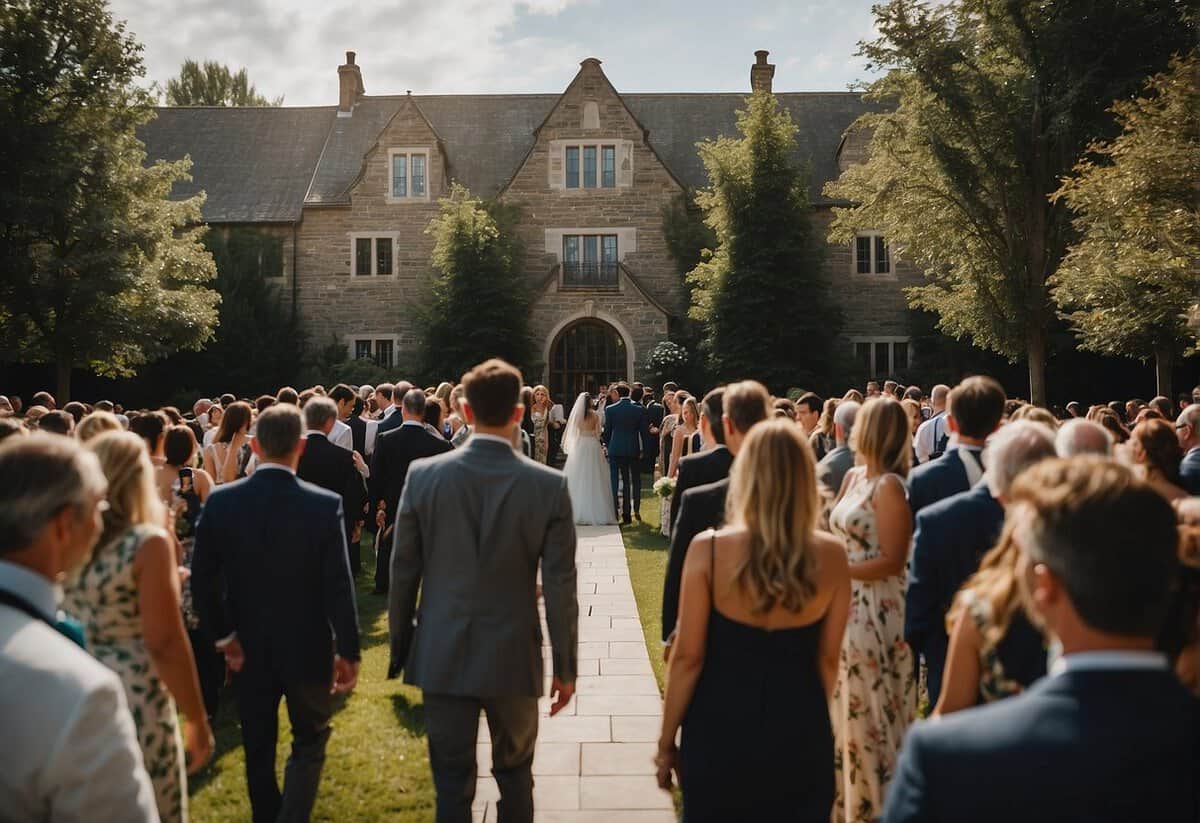
This section answers all of your queries about the order and customs involved in a wedding processional.
What is the traditional wedding processional order?
The traditional wedding processional often begins with the grandparents, parents, groom, best man, and the groomsmen entering the ceremony, followed by the bridesmaids, maid or matron of honor, and finally the bride escorted by her father.
How are participants typically ordered during a wedding processional?
Participants in a wedding processional are typically ordered by their role and relationship to the people getting married. Close family members tend to enter first, followed by the wedding party, and then the bride, creating a structure of anticipation leading up to the bride’s entrance.
In what order should the wedding party walk down the aisle?
Traditionally, the wedding party walks down the aisle in the following order: bridesmaids, maid or matron of honor, ring bearer, flower girl, and finally the bride accompanied by her father or escort.
Who is responsible for escorting the mother of the bride?
The mother of the bride is usually escorted by an usher or a family member, such as a son or close relative, to her seat just before the wedding processional begins.
Can you provide an example of a modern wedding processional sequence?
Yes. In a modern wedding processional, the order can vary but might typically include the officiant leading the way, followed by the groom entering solo or with the best man, the wedding party pairs or individuals, ring bearers, and flower girls, and ending with the bride making her entrance, possibly with one or both parents.
What are the differences between a Catholic wedding processional and a non-religious wedding processional?
A Catholic wedding processional typically includes specific roles like the priest or deacon and may follow a more structured format, which can include altar servers and a crucifer. In contrast, a non-religious wedding processional may have a more flexible order and can be customized according to the couple’s preferences.

